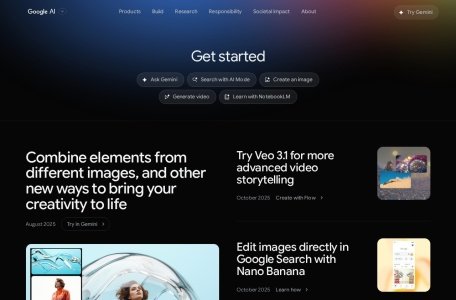
As AlphaGo’s game records fade into history, Google AI is making an even more profound impact on energy revolutions, creative industries, and daily tech life. In 2025, from DeepMind’s cross-sector collaboration with nuclear fusion firms to the scenario-based rollout of the Gemini large language model (LLM), and the AI-driven transformation of search and cloud services, this tech giant has proven through a series of breakthroughs that AI has moved beyond laboratories to become a “core engine for changing the world.” Drawing on Google I/O 2025 highlights and latest partnership updates, this article breaks down how Google AI is reshaping the future through technology.
I. Energy Revolution: A “Stellar Alliance” Between AI and Nuclear Fusion
On October 16, 2025, the announcement of a collaboration between Google DeepMind and Commonwealth Fusion Systems (CFS) – a spin-off from the Massachusetts Institute of Technology (MIT) – was hailed as a “milestone for clean energy.” Their goal is clear: use AI to accelerate the development of CFS’s compact tokamak device, SPARC, with the aim of achieving humanity’s first net energy gain (Q>1) in magnetic confinement fusion by 2027. This means the energy produced by fusion will exceed the energy consumed to sustain the reaction.
Three core technologies underpin this collaboration, with the TORAX simulator standing as the “foundation of foundations”:
1. TORAX: The Differentiable “Digital Tokamak”
Traditional fusion simulators are often fragmented “collections of software patches” written in Fortran or C++. They suffer from inconsistent interfaces and lack differentiability, making them incompatible with modern AI optimization algorithms. DeepMind’s 2024 launch of TORAX has completely upended this status quo:
- Technical Core: Built entirely in Python on Google’s JAX framework, TORAX supports automatic differentiation and GPU/TPU acceleration. It can instantly calculate gradients for complex problems such as “how changes in heating power affect plasma temperature”;
- Practical Impact: CFS teams confirm TORAX has exponentially boosted SPARC’s simulation efficiency. It can run millions of virtual experiments before the device is activated, optimizing pulse designs and plasma trajectory control;
- Open-Source Ecosystem: The derived Gym-TORAX has become a standard environment for reinforcement learning, allowing researchers worldwide to directly develop AI algorithms for fusion control.
2. AI-Powered “Experiment Navigation System”
SPARC features dozens of “control knobs,” from superconducting magnet current to radiofrequency heating. Manual parameter tuning is like searching for a needle in a haystack. DeepMind adapted the Monte Carlo Tree Search (MCTS) technology used in AlphaGo to this challenge: within constraints like material heat load limits, the system quickly identifies parameter combinations that maximize fusion power – cutting experimental trial-and-error costs by over 90%.
II. Model Evolution: Gemini 2.5 Redefines Human-AI Interaction
At Google I/O 2025, the full rollout of Gemini 2.5 took center stage. Its “executive Bot” capabilities have fundamentally changed how users perceive AI:
1. From “Question-Answering” to “Task-Execution”
Gemini 2.5 Pro marks the first LLM to enable end-to-end interaction: “search → organize → navigate → generate.” For example, if a user requests, “Plan a 3-day trip to Tokyo and book a Michelin-starred restaurant,” the model automatically searches for flights, filters dining options, syncs with calendars, and even generates Japanese communication scripts – no human intervention required. This capability stems from its enhanced system connectivity: it can directly call search engines, booking APIs, and local applications.
2. AI-Driven Transformation of Google Search
As the world’s largest AI application scenario, Google Search is undergoing a transformative upgrade:
- Real-Time Interaction: Project Astra’s “Search Live” feature supports real-time camera-based Q&A. For instance, pointing a camera at ingredients and asking for a recipe triggers dynamic image analysis and personalized recommendations;
- Deep Service Integration: Project Mariner’s AI agents are integrated with ticketing and reservation systems. A simple request like “Book tickets for a Saturday play” prompts the AI to compare prices and secure seats automatically;
- Data Visualization: For finance or sports queries, it generates interactive charts on the fly. When analyzing “Tesla’s stock price vs. production capacity over the past 6 months,” it instantly outputs a dynamic line graph.
As of May 2025, AI Overview – a key feature of this upgrade – has reached 1.5 billion monthly active users across 200 countries, driving a 10%+ increase in search engagement in markets like the U.S. and India.
III. Creation & Development: The Boom of GenMedia and AI Agent Ecosystem
Google AI is unlocking creativity through two key avenues: toolchains for developers and generative models for creators.
1. GenMedia: The “All-in-One Engine” for Multimodal Creation
Updates to the GenMedia model series at Google I/O 2025 generated widespread excitement:
- Veo 3 Video Generation: Input a prompt like “A Tokyo subway station in the rain, where an office worker meets a stray cat,” and it generates 4K short films with cinematic shot composition. Users can adjust lighting styles in real time;
- Imagen 4 Image Generation: Honor (Huawei’s sub-brand) has leveraged this model to enable “image-to-video” integrated creation. Upload a product image, and it automatically generates dynamic promotional content;
- Lyria 2 Audio Model: It generates background music matching video footage and can even mimic specific singers’ vocal styles – empowering small teams to produce theater-quality audio-visual content.
2. The “AI Agent Toolkit” for Developers
To meet enterprise needs, Google offers an end-to-end solution from development to deployment:
- Agent Engine Core Suite: Includes the Agent Development Kit (ADK), Agent-to-Agent (A2A) collaboration protocol, and Model Control Platform (MCP). Transsion (a leading African smartphone brand) used this suite to build multilingual AI customer service for African markets;
- AI Scalability with Cloud Run: Supports seamless migration from AI Studio to production environments. Vivo used this service to deploy AI features globally at low cost, reducing GPU inference latency to 50ms;
- Spanner: The “Long-Term Memory” for Agents: As an agent’s “memory bank,” this distributed database stores historical user interaction data. It enables AI to remember preferences like “sugar-free coffee,” delivering personalized experiences.
3. AI Breaks Barriers in Film Production
Ancestra – a short film collaboration between DeepMind and Primordial Soup (a studio founded by renowned director Darren Aronofsky) – premiered at the 2025 Tribeca Film Festival. Blending live-action performances with Veo-generated visual effects, director Eliza McNitt noted: “AI cut the original 6-month VFX timeline down to 2 weeks, while accurately bringing to life imaginative scenes like ‘bioluminescent ancient marine creatures’.”
IV. Responsibility & Future: Google’s Guidelines for AI Ethics
Amid rapid technological advancement, Google AI continues to strengthen ethical boundaries:
- Interpretability Tools: Gemini 2.5 added “Decision Tracing,” allowing users to view the information sources and logical chains behind AI-generated recommendations;
- Philanthropic Applications: Google I/O 2025 featured an “AI for Good” track, showcasing cases like using Gemini to monitor Amazon rainforest wildfires and predict crop pests;
- Data Security: Google Cloud AI services hold ISO 27701 certification. All agent interaction data uses federated learning to prevent privacy breaches.
V. 2025 Practical Guide: How can ordinary people make good use of Google AI?
1. Productivity Tools: Gemini’s “Hidden Features”
- Students: Input “Create a high school physics mechanics test” to generate a question bank with detailed explanations;
- Professionals: Use Gemini Code Assist to optimize Python code. It supports real-time debugging for over 20 programming languages.
2. Creative Support: Getting Started with GenMedia
- Designers: In Imagen 4, input “Cyberpunk-style hutongs in Beijing” to generate assets that can be directly imported into Figma;
- Content Creators: Use Chirp 3 to convert text scripts into emotional podcast audio, with adjustable speed and tone.
3. Daily Life Services: Practical Tips for AI-Powered Search
- Shoppers: Upload a photo to “virtually try on” billions of clothing items worldwide. Set a budget, and it tracks price drops automatically;
- Travelers: Activate Search Live, point your camera at a landmark sign, and get real-time explanations of its historical background.
Conclusion: Google AI’s “Tech Philosophy”
From “humanity-scale challenges” like nuclear fusion to “everyday tasks” like food delivery, Google AI’s 2025 strategy follows a clear logic: use foundational technologies (differentiable physics, reinforcement learning) to break performance ceilings, then deliver AI as “inclusive productivity” through three layers: models, tools, and ecosystems.
Rather than engaging in parameter-focused “arms races,” Google prioritizes “tech accessibility” – TORAX is open-sourced, basic Gemini features are free, and developer tools lower entry barriers. This openness may be the core key to its sustained industry leadership. As AI evolves from a lab “black box” to infrastructure integrated into energy, creation, and daily life, Google is defining the true AI revolution: one that begins with technology and ends with real-world value.
Relevant Navigation


WaCuoWang

Sapling AI Content Detector

AI Content Detector

Seele AI

Trancy

Skywork

DeepLearning.AI

